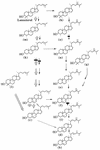Mechanism of amphotericin B resistance in Leishmania donovani promastigotes
- PMID: 9527785
- PMCID: PMC105413
- DOI: 10.1128/AAC.42.2.352
Mechanism of amphotericin B resistance in Leishmania donovani promastigotes
Abstract
Amphotericin B (AmB)-resistant Leishmania donovani promastigotes were selected by increasing drug pressure, and their biological features were compared with those of the wild-type parent strain. The 50% inhibitory concentration for resistant cells was 20 times higher than that for the wild-type. Resistance was stable after more than 40 passages in drug-free medium, and resistant promastigotes were infective to macrophages in vitro but lost their virulence in vivo. They had 2.5 times longer generation time, decreased AmB uptake, and increased AmB efflux in comparison to the wild type. Fluorescence measurement with a specific plasma membrane probe, 1-[4-(trimethylammonio)-1,6-diphenylhexa]-1,3,5-triene, showed increased membrane fluidity in drug-resistant promastigotes. Analysis of lipid composition showed that in resistant cells saturated fatty acids were prevalent, with stearic acid as the major fatty acid, and the major sterol was an ergosterol precursor, the cholesta-5, 7, 24-trien-3beta-ol and not ergosterol as in the AmB-sensitive strain.
Figures




References
-
- Bloch K E. Sterol structure and membrane function. Crit Rev Biochem. 1983;14:47–92. - PubMed
-
- Brassine C, Laduron A, Coune A, Sculier J P, Hollaert C, Collette N, Meunier F. High-performance liquid chromatographic determination of amphotericin B in human serum. J Chromatogr. 1987;419:401–407. - PubMed
MeSH terms
Substances
LinkOut - more resources
Full Text Sources

